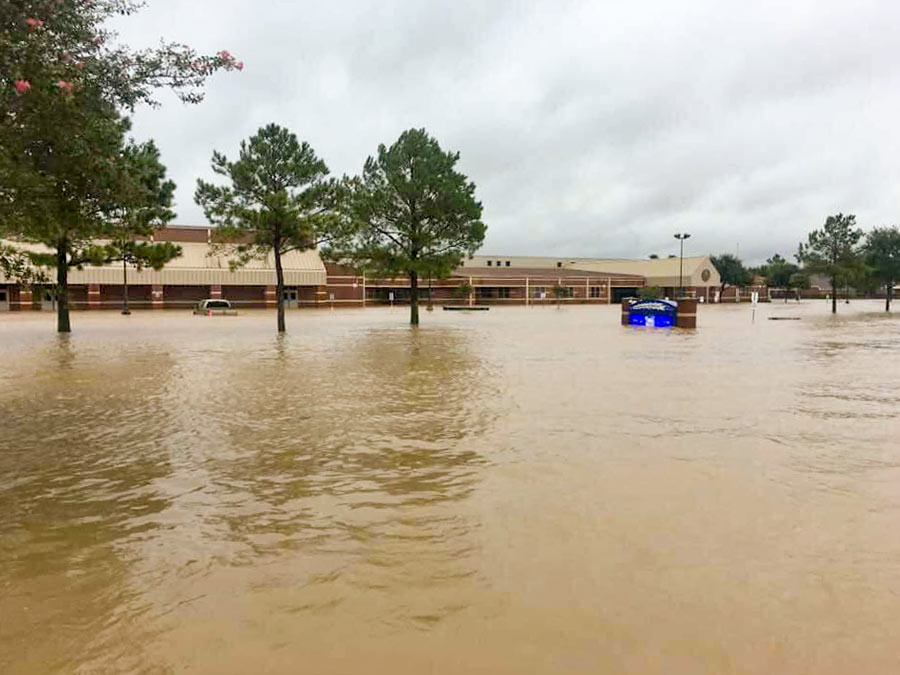The footage above captures Ed Nelson’s high-water trek last Monday through an overflowing detention basin at the corner of Bob White Dr. and Reamer St. just north of Brays Bayou. Nelson narrates his soggy expedition through the basin (which sits at the south end of the Robindell and Braes Timbers neighborhoods, between Hillcroft Ave. and Fondren Rd.) as he attempts to document different flows of water into and out of the pond; he ultimately claims that water is flowing into the detention pond from Brays, and moving from there into the floodway easement running behind nearby houses on Reamer.
Nelson and other neighbors claim that the surrounding area did not flood prior to the detention basin’s completion in 2008, and that the detention pond was intended to collect water from the surrounding neighborhood and prevent it from flowing too quickly into Brays bayou  — whereas during the Tax Day and Memorial Day floods, the basin purportedly collected water from the bayou and channeled it into the neighborhood, causing houses to flood that neighbors believe might not have otherwise.
***
The video ends near the municipal water facility at the south end of the detention pond; also visible is the multi-story complex of Medallion Assisted Living and Seven Acres Jewish Senior Care to the east of the basin.
- Houston neighborhoods shouldn’t be detention ponds
- Sharpstown Area Drainage Improvements Project [Houston Storm Water Management Program]
- Previously on Swamplot: Videos: What S. Braeswood Looks Like Fully Submerged, and Other Aquatified Aerial Houston Scenes; Shots of Brays Bayou Stretching Out along S. Braeswood Dr.; Where Houston Flooded and Where It Didn’t on Memorial Day
Video: Ed Nelson





I don’t understand. He says the Brays topped the bank and water is flowing north into the neighborhood. How could a detention pond make that worse? The detention pond isn’t pumping water out of the bayou. The bayou filled up, then filled the detention pond, then flowed into the neighborhood. How is the detention pond to blame?
That doesn’t make any sense. Unless some kind of unseen levy was removed in order to build the detention pond, how would water just back up in there like that?
It is amazing to me how engineering ‘solutions’ can be so myopic!
This retention pond appears to have been conceived in a vacuum in order to address one single item. Water fills Robindell’s streets: Make temporary detention to collect it.
I saw this at my home. New neigbourhood – downhill – installed grossly undersized culverts because completely ignored the 50 acres of streets and yards that flow through the place. Brand new garages and some homes flooded upon the first 1-2″ rainfall.
I pass another new ‘retention pond’ every day enroute to work. The section of road in front of it is always flooded now… And it remains empty so now it’s only an obstacle to water flow.
This stuff makes me crazy!!!!
Oh, I wanted to say to Ed Nelson:
To be more clear I would suggest filming your walk again (regardless of the water level now) and
make a simple map on paper showing bayou, retention depression, residential streets. Film the map too, as you walk along, oriented with your progress.
(As to the flow of water, I could definitely see it, at first, as you crossed Reamer. But when you were within the city property, due to lighting probably, I didn’t appreciate what you were seeing. A cork with a bright ribbon on it would be worth a 1000 words, I think!)
Good luck to you property owners.
The bayou did not overflow at the time. It was NOT above its banks. The detention pond was cut in and then connected to the bayou. Previously, there was NO connection there. The bayou then had an ‘alternative’ channel and one that was at a lower elevation where the water could go. So rather than water flowing out of the pond and into the bayou, it’s channeling water into the pond and out of the bayou. That makes the surrounding streets an alternative riverway for the bayou. The pond was built to slow down water from Sharpstown and prevent it from going into the bayou too quickly. It was NOT created to be part of the bayou’s detention needs. Before it was there, a direct connection to the bayou did not exist. So yes, in effect, a levy was removed by providing a giant hole in the side of the bayou that gives access to an alternative path. Much concern was expressed when it was built originally, but then and every time since then, those concerns were ignored by every administration.
It’s common sense, if the pressure FROM Braes Bayou is greater than what is in the retention pond, it WILL flow back into the pond and into the streets. In this case the Reamer St is higher in elevation by the retention pond than the other end closer to Hillcroft. Because of that, the water flowed down Reamer keeping the area closer to Hillcroft flooded hours longer than other streets.
Hi, I’m Ed Nelson and I shot the video. It is very unrehearsed. If it is less than clear, I apologize. There is a second video showing the state of the bayou at the same time. Brays bayou was high but not over topping the north bank. I posted it on the same YouTube channel. The problem started when the detention basin was built without consideration of the bank height of Brays bayou. The basin is connected to Brays Bayou by a line of approximately 50″ diameter that drains Sharpstown water in and out of the basin. The basin is about 100 yards north of the bayou. Since parts of the top of the basin are lower than the maximum bank height of Brays bayou, it can back flow. The volume leaving the basin was quite large. There are two practical solutions to the problem. One is a storm gate at the bayou that could be shut by water in the bayou. The problem is that this could clog or jam and that it may restrict water too soon. The other is to raise the top of the basin higher than the bayou. This is more expensive but will work. It will certainly be less costly than a third unnecessary flood. The City owes the greater Robindell community this. And promptly.
Also to be clear. The retention pond was not built FOR Robindell. It was not built to retain water that falls in Robindell. It was built to house water draining off from Sharpstown. That drain already had it’s own path. The city cut into that path and channeled it into a retention pond which they built IN Robindell for that purpose. The detention pond itself has no supporting association with the area in which it’s located. It was not meant to serve Robindell and now, instead, menaces it.
I live nearby. The water topped the north bank of Brays Bayou by Hillcroft, there at the Shell station. I saw it.
That’s not much of a detention pond. Mike Driscoll park further upstream is probably 25x the size of that pond. Maybe the city/county/municipal authorities need to build more detention ponds like Mike Driscoll park.
Membag,
Yes, you make a great point: the bayou over topped at Hillcroft.
But the retention pond is upstream from there, over a quarter mile away.
The water ran *down* from McAvoy, along Reamer, to meet the water.
The drainage pattern in Robindell is very complex.
If the storm sewers are filled with bayou water draining out of the pond from Brays, the capacity downstream is compromised.
Dunlop flooded, and this was more likely the water from Hillcroft/Brays bayou, as well as the over capacity impact from the detention pond over flow.
Check out http://www.gims.houstontx.gov/gims/default.aspx?app_id=gims&app=GIMS&AppID=-1&app=GIMS and turn on the stormwater layer. Zoom to the robindell detention pond. Click on stormwater line, strormwater devices and abandoned stormwater line. You can see where the city spliced the line running into Brays Bayou to allow the retention pond to fill. Problem is when the detention pond fills it creates a wall for the remaining water up the line. The first point for it to back up is the type E-inlet across Reamer. If you notice in the video you can see the water really start to move just pass the truck. That is the water being displaced from the E-inlet. Go back to GIMS and look how much area that 66″ line drains further upstream. Instead of all of the water being siphoned out into Brays like it once was, it is now spilling out of this inlet and all of the water from up the line is channeling down our new mini Brays Bayou (Reamer Street) in Robindell. I’m no engineer, but the problem seems pretty obvious. That is a lot of water to hold in an olympic sized swimming pool of a pond. There has to be some way of getting the water straight to the bayou like it once did. That pond serves absolutely no purpose other than to nest an occasional waterfowl.